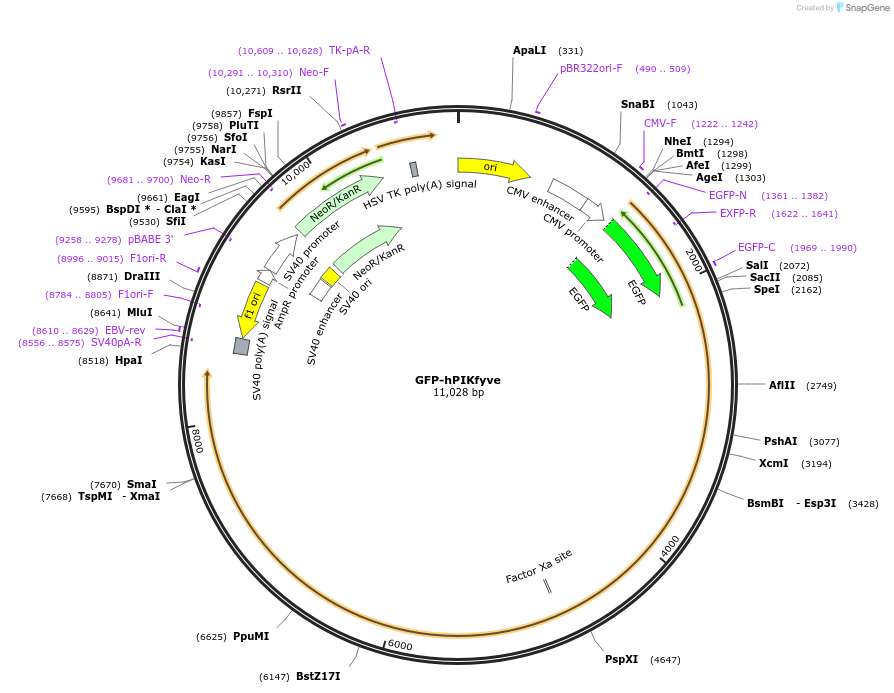-
PurposeExpresses GFP-tagged human PIKfyve in mammalian cells.
-
Depositing Lab
-
Sequence Information
Ordering
| Item | Catalog # | Description | Quantity | Price (USD) | |
|---|---|---|---|---|---|
| Plasmid | 121148 | Standard format: Plasmid sent in bacteria as agar stab | 1 | $89 | |
Backbone
-
Vector backbonepEGFP-C1
-
Backbone manufacturerClontech
-
Vector typeMammalian Expression
Growth in Bacteria
-
Bacterial Resistance(s)Kanamycin, 50 μg/mL
-
Growth Temperature37°C
-
Growth Strain(s)DH5alpha
-
Copy numberHigh Copy
Gene/Insert
-
Gene/Insert name1-phosphatidylinositol 3-phosphate 5-kinase isoform 2
-
Alt namePIKfyve
-
Alt nameType III PIP kinase
-
Alt namePIP5K3
-
SpeciesH. sapiens (human)
-
Insert Size (bp)7026
-
GenBank IDNP_055855.2
-
Entrez GenePIKFYVE (a.k.a. CFD, FAB1, HEL37, PIP5K, PIP5K3, ZFYVE29)
- Promoter CMV
-
Tag
/ Fusion Protein
- GFP (N terminal on insert)
Cloning Information
- Cloning method Restriction Enzyme
- 5′ cloning site EcoRI (not destroyed)
- 3′ cloning site BamHI (not destroyed)
- 5′ sequencing primer CATGGTCCTGCTGGAGTTCGTG
- 3′ sequencing primer GAAATTTGTGATGCTATTGC
- (Common Sequencing Primers)
Resource Information
-
Articles Citing this Plasmid
Terms and Licenses
-
Academic/Nonprofit Terms
-
Industry Terms
- Not Available to Industry
Trademarks:
- Zeocin® is an InvivoGen trademark.
These plasmids were created by your colleagues. Please acknowledge the Principal Investigator, cite the article in which the plasmids were described, and include Addgene in the Materials and Methods of your future publications.
-
For your Materials & Methods section:
GFP-hPIKfyve was a gift from Geert van den Bogaart (Addgene plasmid # 121148 ; http://n2t.net/addgene:121148 ; RRID:Addgene_121148) -
For your References section:
The Phosphoinositide Kinase PIKfyve Promotes Cathepsin-S-Mediated Major Histocompatibility Complex Class II Antigen Presentation. Baranov MV, Bianchi F, Schirmacher A, van Aart MAC, Maassen S, Muntjewerff EM, Dingjan I, Ter Beest M, Verdoes M, Keyser SGL, Bertozzi CR, Diederichsen U, van den Bogaart G. iScience. 2019 Jan 25;11:160-177. doi: 10.1016/j.isci.2018.12.015. Epub 2018 Dec 20. 10.1016/j.isci.2018.12.015 PubMed 30612035







